"Snailing" is an abrasive finish in which a pattern of circular arcs is arranged in one or more bands around the central hub of a watch wheel. It is often described as "spiral," and indeed the play of light on it can strongly suggest spirals, but the underlying pattern is one of circular arcs.
As shown in the video by Pahlow (see below), it is produced by the action of an abrasive lap which is the end of a tube. This tube partially overlaps the workpiece, and rotates to produce the circular arcs characteristic of snailing. The workpiece also rotates, causing these arcs to form a pattern in a circular band.
Here is a photograph of a single band of snailing applied to a watch wheel (almost certainly the wheel atop a mainspring barrel; see the stopwork on the engaging wheel in the upper right corner). This image shows quite clearly both the underlying circular arc pattern of the snailing and the compelling illusion of a spiral pattern produced by the play of light on it.
(Photograph by flickr user pjern (Phil Jern) at http://www.flickr.com/photos/pjern/6076254491/ License: Creative Commons Attribution - NonCommercial, No-Derivatives 2.0.)
The best way to understand snailing is to watch the video by Steffen Pahlow, "Der Sonnenschliff für Rad-Oberflächen" / "Snailing for wheel surfaces" (2011). This may be seen most easily on his youtube site, http://www.youtube.com/user/spahlow. where it is at: http://www.youtube.com/watch?v=S_S8oA9HdlY ("Watchmaking, How develops a pattern like snailing, der Sonnenschliff." It may also be seen in QuickTime format on his own website, http://www.s1p.de/z/mi2e.html
Snailing is described in Claudius Saunier's The Watchmakers' Hand-Book as translated into English by Julien Tripplin and Edward Rigg (London: J. Tripplin, 1881)
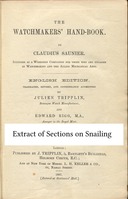
There is a difference in the procedure described by Saunier and that shown by Pahlow in his video. In Pahlow's video, the workpiece and the snailing tube are rotated in opposite directions, each under power. In Saunier, the workpiece is not powered but rather is caused to rotate by the movement of the snailing tube on it (page 118). Indeed, Saunier says "it may be observed that, if the axes of both the steel piece [the workpiece] and lap [the snailing tube] were driven by bows or otherwise, the surface would be polished and not snailed" (p. 119).
Saunier's treatment is a trifle confusing at first.
He begins by considering the topic of "wavy and curvilinear smoothing" (in Section 173). These processes are "smoothing" processes only insofar as they take a machined surface and produce on it a smoother surface by abrasion (all polishing processes are really just the production of rough surfaces at a finer and finer level).
He divides the topic of "wavy and curvilinear smoothing" into two subtopics: (a) the production of wavy/curvilinear patterns which are "entire circles," and (b) the production of wavy/curvilinear patterns which "radiate in curves."
All of this has been happening in a section of Saunier devoted to the finishing of brass. So he goes on to discuss the first of these divisions ("entire circles") in the next section (Section 174) under the heading "Circular Snailing or Spotting." It would appear therefore that he sees this as essentially a technique for finishing brass, although it has often been applied to steel. He defers the discussion of the second of these divisions ("radiate in curves") until Section 178, which is a part of his discussion of the Smoothing of Steel. This discussion in Section 178 is Saunier's coverage of snailing proper.
This type of finish is describe in Sermier, Caroline and Giulio Papi. High-End Horological Finishing and Decoration. (Le Locle, CH: Audemars Piguet, 2006): 103. Much the same text also appears in material by Sermier on the "watches-lexic" website, at: http://www.watches-lexic.ch/pages/eng/tec/fs_exp21.htm
Note that the order of presentation of the photographs on this website is a bit confusing. As I write this in 2012-08-06, the top two photographs show Côtes de Genève. The second photograph, with the yellow background, shows Snailing. (This photograph appears, with postprocessing, in Sermier's book. The direct link to the image online is: http://www.watches-lexic.ch/pics/expert/aprp6A3.jpg) The fourth photograph shows Sunray Brushing. I'm not at all sure what the final photograph is intended to show; it does not appear to show the next topic in Sermier's presentation, Circular Graining.
Note further that Sermier's photograph of Snailing is a bit misleading. It has a strong pattern of light and dark shading from the central hub; the eye wants to follow this pattern and identify its countour as the snailing. However, closer inspection shows the actual pattern of arcs of the snailing as abraded into the wheel itself.
Here is an example from American watchmaking. It is a Hamilton 917 pocket watch movement (retrofitted into a wristwatch case), photographed by flickr user "Malenkov in Exile" (Shane Lin). The wheel (gear) on the mainspring barrel shows three bands of snailing which, taken together, give a strong impression of a spiral pattern. Close examination will show that the abraded marks are actually all circular arcs.
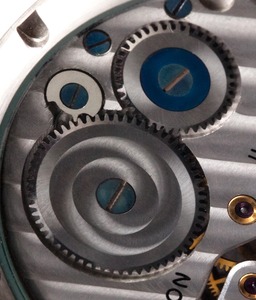
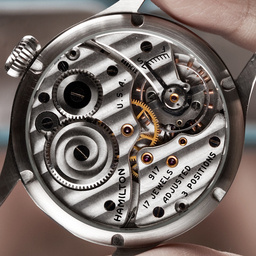
(Both of these images also show Côtes de Genève. The second image is actually a link to its re-presentation on the Notebook on that topic.)
(Images by flickr user "Malenkov in Exile" (Shane Lin) at http://www.flickr.com/photos/shanelin/5757406305/ and http://www.flickr.com/photos/shanelin/5366671496/ License: Creative Commons Attribution-NonCommercial 2.0.)
Here's a much simpler example. Again, the snailing is on the mainspring barrel. (The movement as a whole displays Côtes de Genève and a little bit of Spotting. )
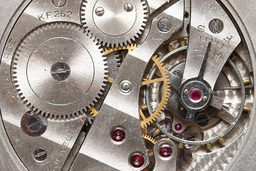
(Image by flickr user Monty Hood, at http://www.flickr.com/photos/montyhood/4414773547/ License: Creative Commons Attribution - ShareAlike - Noncommercial 2.0.)
Here's a view of some more subtle snailing, in this instance on an E. Howard pocket watch owned by (and photographed by) flickr user Phil Romans. Again, the snailing is on the mainspring barrel. The watch as a whole has a circular banded pattern to it. It isn't clear to me whether you'd call this overall pattern a kind of snailing, or whether it is a circular variation of Côtes de Genève. I suspect the latter.

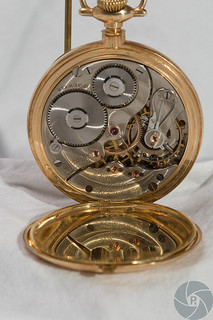
(Photographs by flickr user Phil Romans at http://www.flickr.com/photos/mdu2boy/3112347808/in/photostream and http://www.flickr.com/photos/mdu2boy/3111502335/in/photostream License: Creative Commons Attribution - Noncommercial - NoDerivatives.
The photograph by flickr user pjern (Phil Jern) is licensed under the Creative Commons Attribution - NonCommercial - No-Derivatives 2.0 license. Please note that this license is more restritive than the licensing of the rest of this present page; it forbids both commercial use and derivative versions. My own use here is noncommercial, and I have not altered this image in any way.
The Hamilton 917 photographs by flickr user "Malenkov in Exile," and any derivative versions here, are licensed under the Creative Commons Attribution-NonCommercial 2.0 license. Please note that this license is more restrictive than the license of the rest of this present web page; it forbids commercial use (my own use here is noncommercial).
The photograph by flickr user Monty Hood is licensed under the Creative Commons Attribution-ShareAlike-NonCommercial 2.0 license. Please note that this license is more restrictive than the license of the rest of this present web page; it forbids commercial use (my own use here is noncommercial).
The photographs by flickr user Phil Romans are licensed under the Creative Commons Attribution-NonCommercial-NoDerivatives 2.0 license. Please note that this license is more restrictive than the license of the rest of this present web page; it forbids commercial use (my own use here is noncommercial) and derivative versions (each use of these images on this site is an exact copy of it as downloaded from flickr).
All portions of this document not noted otherwise are Copyright © 2012 by David M. MacMillan and Rollande Krandall.
Circuitous Root is a Registered Trademark of David M. MacMillan and Rollande Krandall.
This work is licensed under the Creative Commons "Attribution - ShareAlike" license. See http://creativecommons.org/licenses/by-sa/3.0/ for its terms.
Presented originally by Circuitous Root®
Select Resolution: 0 [other resolutions temporarily disabled due to lack of disk space]